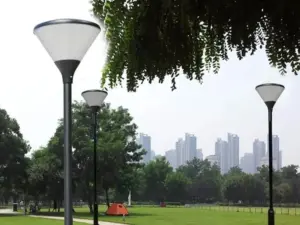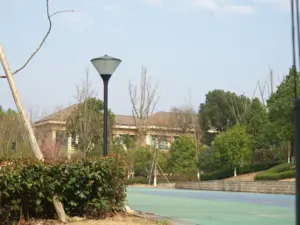导言:
安装花园灯可以为您的户外空间增添美丽的氛围,并提升花园的整体外观。以下是帮助您安装花园灯的分步指南。
在开始了解如何安装花园灯之前

查看当地法规:
在开始任何电气工作之前,请确保您熟悉当地有关户外照明安装的建筑规范和法规。
选择照明设备:
决定要安装的庭院灯类型。可选择太阳能灯、低压 LED 灯或传统的 120V 灯。
制定照明计划:
白天绕着花园走一圈,规划花园照明设施。考虑突出主要特征,如小径、植物、树木或焦点。
收集工具和材料:
- 安装花园灯和灯具蓝图(平面图)
- 室外电缆(如需要)
- 变压器(用于低压系统)
- 连接器、电缆钉和电缆连接器
- 螺丝刀
- 剥线器/切割器
- 铲子(如果埋设电缆)
- 防水电线螺母或电工胶带
如何安装花园灯?分步指南

准备灯光
如果花园照明装置需要组装,请按照制造商的说明进行组装。
在了解如何安装庭院灯之前,电源选择很重要
- 太阳能灯:选择白天阳光充足的地方。
- 低压灯决定变压器的位置。变压器应靠近室外电源插座,并避免受到风雨侵袭。
安装变压器(用于低压系统):
- 将变压器安装在墙上或电源插座附近的坚固表面上。
- 将室外额定电源线连接到插座上,并将其引向变压器。留出足够的松弛空间,以便于连接。
- 按照制造商的说明,将电源线连接到变压器上。
铺设电缆
对于低压系统,应沿规划的照明路径铺设室外电缆。可以将电缆埋在地下几英寸处,或用电缆钉将其固定在地面上,以便更好地安装花园灯。
连接花园灯
- 对于太阳能灯:只需将它们放在指定的位置,确保它们在白天能接收到足够的阳光。
- 对于低压和 120V 灯具:按照制造商的说明,使用电缆连接器或灯具随附的连接器将每个灯具连接到电缆上。使用防水导线螺母或电工胶带固定连接。
测试灯光
在埋设电缆(如适用)或最终完成安装之前,请测试每个灯具,以确保其正常工作。
安全电缆(用于低压系统)
- 一旦所有花园照明安装连接都经过测试并正常工作,就将电缆沿规划路径埋入地下几英寸处。
- 另外,也可以用电缆钉将电缆固定在地面上,并尽可能保持隐蔽。
调整和瞄准灯光
根据照明计划确定每盏灯的位置,调整方向和角度,以达到所需的照明效果。
完成安装
- 对于太阳能灯:确保安装花园灯的位置正确,白天能接受到充足的阳光。
- 用于低压和 120V 灯:仔细检查所有连接,确保电缆牢固。
开灯
安装完成后,打开灯光,享受它们为花园营造的美丽氛围。请记住,如果您不确定如何安装花园灯或安装过程中的任何环节,请咨询专业电工,以确保安全和正确的安装。
自己安装庭院灯安全吗?

安装花园灯可以是一项既有成就感又相对简单的 DIY 项目,尤其是如果您选择太阳能灯或低压系统的话。不过,在用电作业时,安全始终是重中之重。是自己安装花园灯还是请专业人员安装取决于几个因素:
1.技能和经验
DIY:如果你有基本的电气工作经验,并对处理电气连接有信心,你也许可以自己动手安装花园照明,尤其是在使用太阳能灯或低压系统的情况下。
专业人员:如果您在电气工作方面经验有限或毫无经验,最好聘请有执照的电工。专业人员将具备根据当地建筑法规安全处理电气连接的专业知识。
2.电气知识
DIY:如果你对电气原理有很好的了解,知道如何使用电线和连接器,并能看懂电路图,你就可以轻松地自己动手安装了。
专业:如果电气工作对您来说是一个陌生的领域,专业电工将具备相关知识和专业技能来应对潜在的挑战,并确保正确、安全地完成安装。
3.电气法规和条例
DIY:如果您决定自己动手,就必须熟悉当地的电气规范和法规。户外电气工程通常有特定的要求,以确保安全和合规。
专业:电工精通当地的建筑规范和法规。聘请专业人员可确保花园照明安装符合所有安全和法律要求。
4.灯的电压
自己动手:对于 DIY 爱好者来说,太阳能灯和低压系统(12V)通常更安全,也更容易安装。低压系统的设计更方便用户使用,触电风险也更低。
专业人员:如果计划安装 120V 灯具或任何其他高压照明系统,最好聘请有执照的电工。使用高压会带来更大的风险,只有经验丰富的专业人员才能处理此类安装工作。
5.项目的复杂性
自己动手:对于简单的安装,例如沿小路安装太阳能灯,如果你有必要的工具并遵守安全准则,DIY 可能是合适的。
专业:对于更复杂的设置,如将多个照明灯具与变压器整合、埋设电线或处理更高的电压系统,强烈建议聘请花园照明安装人员,以确保安装安全可靠。
6.时间和便利
自己动手:自己动手可以省钱,但也需要时间和精力来研究、规划和正确安装。
专业:雇用专业电工可以减轻您的负担,因为他们拥有高效、安全地完成工作的知识和工具。
安装花园灯的成本
安装庭院灯可以很好地提升户外空间的美观性和功能性。庭院灯不仅可以为您的庭院增添一抹优雅的氛围,还能在夜晚提供更多的安全保障。不过,安装庭院灯的费用会因多种因素而异。
让我们来探讨一下安装庭院灯的一些主要成本考虑因素:
花园灯类型:
安装庭院灯的费用因您选择的类型而异。有多种选择,包括太阳能灯、LED 灯、低压灯和传统有线灯。太阳能灯往往更实惠,因为它们不需要电线,而 LED 灯节能,使用寿命更长,但前期费用可能更高。
灯的数量
安装的灯越多,花园灯的安装费用就越高。所需的灯具数量取决于花园的大小和所需的照明程度。花园越大或照明设计越精细,自然需要更多的灯,从而增加安装费用。
灯光质量:
灯具的质量会对成本产生重大影响。质量更高的庭院灯可能更耐用,性能更好,但价格也可能更高。必须在成本和质量之间取得平衡,才能获得持久高效的灯具。
安装方法:
您选择的安装方式也会影响花园灯的安装费用。如果您选择太阳能灯或低压灯,您也许可以自己安装,从而降低人工成本。
结论
总之,自己动手安装庭院灯是安全的,但这取决于您的电气专业水平和项目的复杂程度。对于太阳能灯或低压系统等简单的安装,如果您具备必要的知识和技能,DIY 不失为一种可行的选择。
但是,如果要进行更复杂的安装、使用更高的电压,或者您缺乏电气经验,最好还是聘请一名持证电工,以确保安全和专业的安装。在处理用电问题时,安全始终是重中之重,因此,如果您对项目的任何方面不确定,咨询专业人员是最好的办法。
